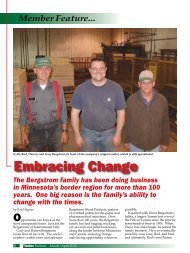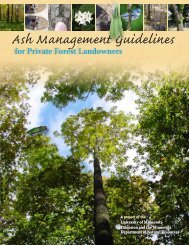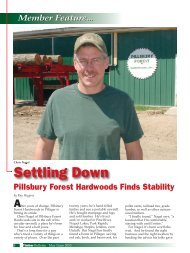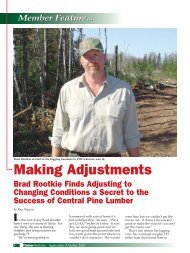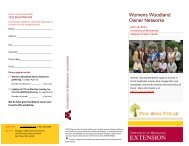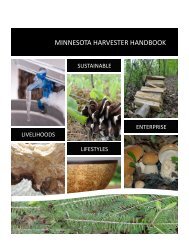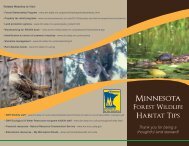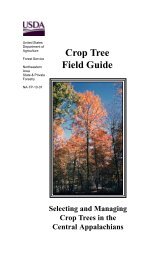Ash Management Guide for Private Forest Landowners
Ash Management Guide for Private Forest Landowners
Ash Management Guide for Private Forest Landowners
Create successful ePaper yourself
Turn your PDF publications into a flip-book with our unique Google optimized e-Paper software.
Chapter 7Other Implicationsof EAB and <strong>Ash</strong> TreesEpicormicbranchingDefects in ash treesThere are as many ways <strong>for</strong> trees tofail as there are trees. An ice storm canoverload all the branches on a tree, ablustery wind can blow down a tree if itsroots are restricted or a cracked tree canfail just under its own weight.Trees are designed to easily withstandthe normal windstorms and winterstorms that occur, yet we have all seentrees that have failed. Trees fail when theload (weight and motion of the crown)exceeds the mechanical strength of theirbranches, stems or root systems. This istrue <strong>for</strong> both sound and defective trees,Photo: Ed Czerwinskibut defective trees can only withstand afraction of the load that sound trees canwithstand. Defective trees fail soonerthan sound trees.A sound tree becomes potentiallydangerous when the tree’s woody structureis weakened by one or more defects.Most defects can be linked to pastwounding and decay, pest infestations,severe storms, or to growing conditionsthat limited the root system. Sincedefects, the old injury sites and nearbywood, are structurally weaker thanuninjured wood, the tree is predisposedto fail at the location of the defects.Defective trees can be found growinganywhere. <strong>Management</strong> of a defectivetree is at the landowner’s discretion. It issuggested that if defective trees or deadtrees could fall onto structures, yards,fences, driveways or recreational trails,a landowner might consider removingthem. On the positive side, defective andfallen trees provide wildlife habitat andother important ecological services. Asa species group, ash are susceptible totwo main defects; root system failureand branch failure. In many soil types,ash root systems are quite shallow,making the trees prone to windthrow.Commonly the entire tree and much ofits root system tip over during strongwinds, especially in exposed locations.Branches are likely to fail at the junctionof the branch and the stem due to thepresence of bark growing inside the treeand/or the presence of serious decay inthe same location. Branch failure is moreprevalent in large diameter trees.For in<strong>for</strong>mation on where to find the full resourceon defects in ash trees see Appendix D, page 66.58



